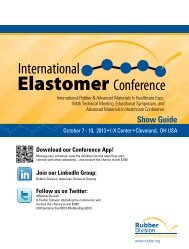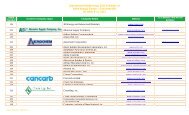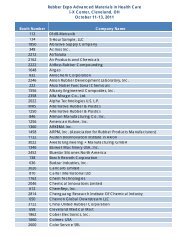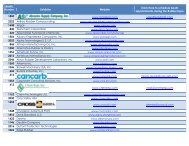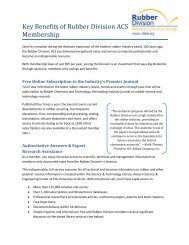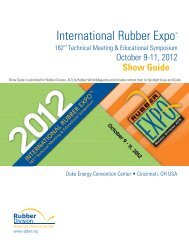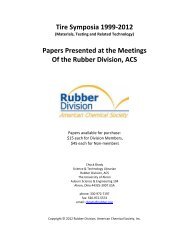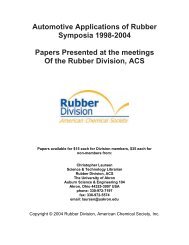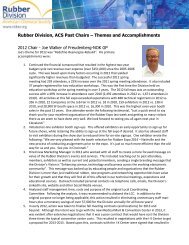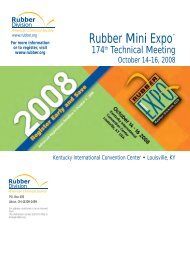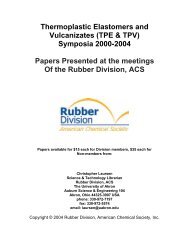Training Directory - Rubber Division
Training Directory - Rubber Division
Training Directory - Rubber Division
You also want an ePaper? Increase the reach of your titles
YUMPU automatically turns print PDFs into web optimized ePapers that Google loves.
MANUFACTURING & PROCESSING<br />
Fundamentals of Color and<br />
Appearance<br />
7 hours<br />
CEUs: .7<br />
The objective of the Fundamentals of Color and Appearance<br />
course is to get a basic understanding of how to communicate<br />
and control color. Topics in this course include basic color<br />
vocabulary, color concepts on light sources, visual and numeric<br />
assessment, how an object interacts with color, and appearance<br />
and setting tolerances.<br />
Agenda:<br />
Basic Color Theory: object, observer, source<br />
Appearance: grain, gloss, texture and color<br />
Color Instruments<br />
Assessment: instrumental and visual<br />
Tolerancing<br />
Engineering with <strong>Rubber</strong>:<br />
An Introduction<br />
14 hours<br />
CEUs: 1.4<br />
This course will introduce engineers and others to the basics of<br />
elastomeric materials and their use as engineering materials.<br />
Day 1 – <strong>Rubber</strong> As An Engineering Material<br />
Introduction - What Polymers Are, How They Behave<br />
Elastomers - What Makes Them Up, How They Differ<br />
From Plastics<br />
<strong>Rubber</strong> Compounds - What Are They?<br />
Properties of <strong>Rubber</strong> - Their Standard Characteristics<br />
Processing <strong>Rubber</strong> - Making the Product<br />
Bonding - Sometimes Essential<br />
Engineering Properties - Flexing, Environmental Resistance, Life<br />
Dynamic Properties - Stress/Strain Responses, Test Methods<br />
Quality Control - How to Know It’s Right<br />
Specifi cations - What They Mean and Don’t Mean<br />
Day 2 – Product Design Considerations<br />
Introduction to Design Applications<br />
<strong>Rubber</strong> as an Engineering Material<br />
Vibration Isolation/Shock Absorption<br />
Load Bearing Applications<br />
Seals<br />
Dynamic Mechanical Properties<br />
Stiffness<br />
Incompressibility and Shape Factor<br />
Linear vs. Non-Linear - Linear/stiffening/Buckling (Softening)<br />
Modulus - Frequency/Strain/Temperature<br />
Damping<br />
Definitions<br />
Transmissibility<br />
Compression Set/Drift/Relaxation<br />
Component Design<br />
Shear Mount<br />
Bending Effects<br />
Compression Mount<br />
Tube Form – Radial/Torsional/Cocking<br />
Parallel vs. Serial Mountings<br />
Use of Shims in Laminates<br />
Inclined Mountings<br />
Internal Heat Generation<br />
Fatigue Considerations<br />
Vibration Isolation<br />
Focalized Systems<br />
Shock Isolation<br />
Dynamic Environments<br />
Practical Design Details<br />
Design for uniform stress<br />
Dimensional tolerances<br />
Installation<br />
Causes of Failure<br />
Typical Mountings<br />
Flexible Couplings<br />
Seals<br />
6 RUBBER DIVISON, ACS EDUCATION OPPORTUNITIES



